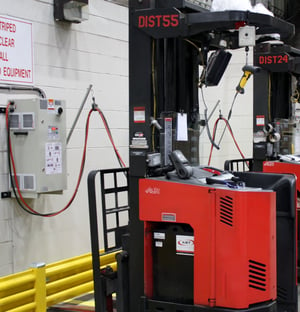 As with most technologies, the only constant is change. As soon as your business falls into a rhythm, new innovations come along that make you question whether or not you need to upgrade. In the motive power world, it's no different. Advances in batteries and charging techniques mean you should always be evaluating your material handling operation.
As with most technologies, the only constant is change. As soon as your business falls into a rhythm, new innovations come along that make you question whether or not you need to upgrade. In the motive power world, it's no different. Advances in batteries and charging techniques mean you should always be evaluating your material handling operation.
Standard Battery Charging
The way operations charge their batteries has also changed over the years. However, the most common way to charge your battery is through one cycle a day. This breaks down to:
- 8 hours of discharge (work)
- 8 hours of charging (16% to 18% start rate of the battery capacity)
- 8 hours of rest
- Weekly equalizations to keep batteries healthy
Keep in mind, this standard way of charging is ideal for one-shift operations. This gives the batteries plenty of time to charge, then rest. However, for multi-shift operations, things get more complicated. Now batteries have to be changed out and rotated. While there are efficient ways to do this, there are also downsides:
- Changing out equipment is expensive
- There are safety concerns
- Productivity can be negatively impacted
- Potentially shorter run times
- Battery replacements earlier than expected
- A chance of higher repair costs
Opportunity Battery Charging
Through an assessment of your typical workday, you can figure out ways to maximize your charging efforts. With a 25% start rate for faster charge times, opportunity chargers are programmed to shut off at 80% during the work shifts to limit the cycles used and control the amount of heat generated. Weekly equalizations are also needed to keep the batteries healthy and in warranty compliance. For operations with longer shifts, this can negate the battery changing we mentioned earlier and can also increase the lifespan of an older battery.
Opportunity charging definitely starts to make more sense for multi-shift applications. The charge rates are different (25% start rate of the battery capacity) since you're charging more frequently and at a higher start rate to return the ampere-hours quicker. The "opportunity" refers to the times operators can use to charge; for example, charging typically takes place between breaks and lunches, or anytime the trucks are not in use.
So What’s the Catch?
On paper, opportunity charging sounds like the more efficient path unless you're running a single-shift operation. However, even if your operation is conducive to opportunity charging, there are some additional factors to consider:
- There is an infrastructure cost to locate chargers near break rooms or work areas so it’s convenient for operators to charge.
- You’ll have to enforce the discipline to charge during breaks and lunches so the truck can make it through the shifts.
- You must ensure that trucks are plugged up for a consistent 12 hours to receive an equalization weekly—and keep in mind that seven-day operations have a different challenge.
Even with these factors, by opportunity charging you can still save money over the long term by using fewer batteries, changing out equipment less, and mitigating the loss of productivity/labor needed to change out your batteries.
Which Battery Charging Method Is Best for My Business?
The answer to this question depends entirely on your operation. A constant theme throughout this article is about shift structure—your specific needs will initially be based on that. Then it's time to take a look at the batteries you're using. Many of the concerns associated with opportunity charging come from companies using the technique on conventional chargers that aren't designed for that charging method. Typically, this is what leads to the thermal issues that can damage the batteries.
A fleet evaluation can undercover what solution will work best for you. It's quite possible that a shift to a motive power solution built for opportunity charging can save your company time and money over the long haul. In a truly efficient motive power solution, each part works in concert to create an efficient whole.


 Ryan Lynch
Ryan Lynch